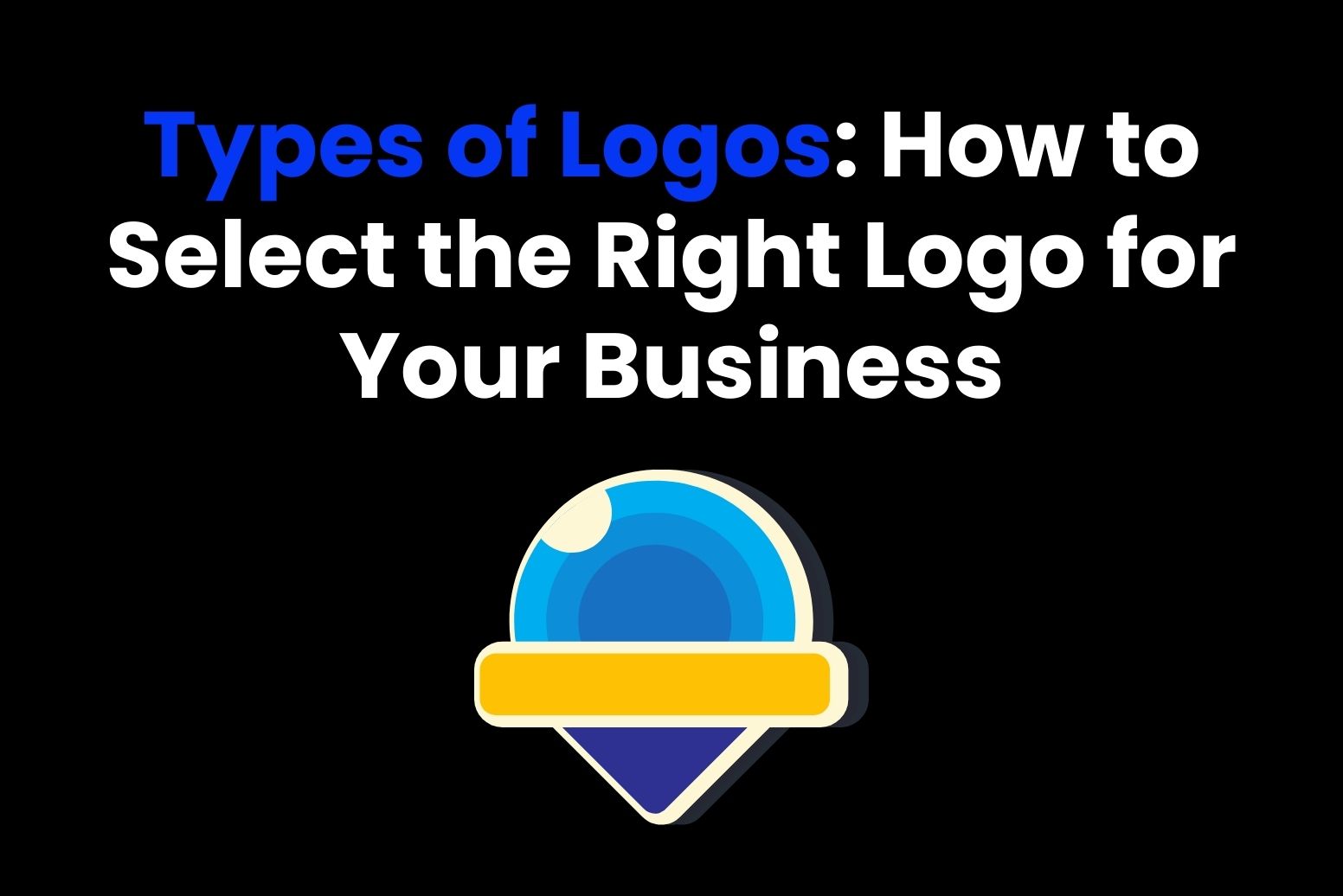A logo is the face of a brand, playing a very important role in shaping its identity and perception. It is a graphical representation of your business that communicates its essence at a glance. Beyond aesthetics, well-crafted types of logos foster brand recognition and leave a lasting impression on customers. Designing the right logo requires understanding its significance and aligning it with your business values and goals. In this article, we are going to explore the different types of logos:
Part 1: What is a Logo?
A logo is a symbolic representation of a business, often incorporating text, imagery, or a combination of both. It serves as a visual cue, helping customers identify and remember a brand. Logos are crucial for establishing brand identity and creating an emotional connection with the audience.
Why Logo Design Matters
Logos typically serve as the first encounter a customer will have with a brand. A well-designed logo can clearly portray professionalism and trustworthiness, thereby giving a business a competitive advantage. From sleek, minimalist designs to bold, vibrant marks, the logo can set the pace of just how a customer perceives a business.
1. Types of Logos
Although types of logos may come in various designs, each one is unique in representing a brand’s personality. From text-based designs to intricate illustrations, logo types can be broadly categorized into the following:
- Wordmarks (Logotypes)
- Lettermarks (Monogram Logos)
- Pictorial Marks
- Abstract Marks
- Mascots
- Combination Marks
- Emblems
- Dynamic Logos
Why It’s Important to Choose the Right Logo Type?
The choice of logo type is an important one since it affects your brand perception. The suitable logo type should match the kind of industry, values, and target audience your brand has in order to evoke maximum resonance and recognition. In other words, a modern startup in tech may use a sleek wordmark, while a family restaurant would go for a mascot in order to depict warmth and approachability.
Part 2: Detailed overview of types of logos
1. Wordmarks
Wordmarks, also referred to as logotypes, fully depict the name of the business. Types of logos involving wordmarks use personal typography or specific fonts for making the brand’s name stand out. Thus, The simplicity of wordmarks ensures clarity and easily recognizing it makes it suitable for companies whose names are unique or memorable.
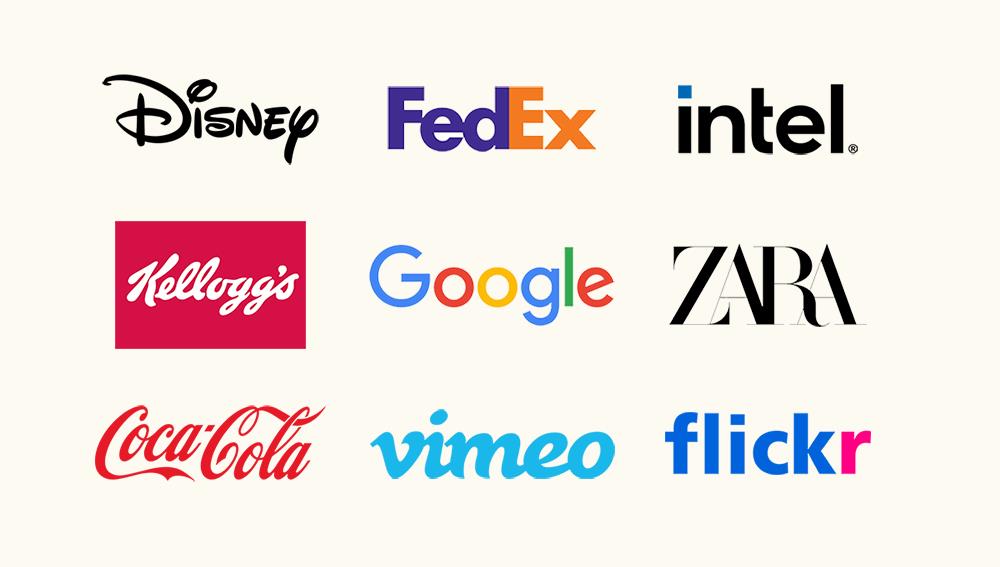
Examples
- Google: Clean and colorful reflecting innovation and creativity
- Coca-Cola: in script-style evokes heritage and tradition.
- Netflix: Bold, modern lettering that conveys simplicity and strength.
Best Use Cases
- Unique Business Names: When the company name is distinct or highly recognizable, a wordmark amplifies its impact.
- Brand Focus: Ideal for startups and businesses prioritizing brand awareness over other design elements.
- Industries: Commonly used in technology, fashion, media, and luxury sectors.
2. Lettermarks
Lettermarks also referred to as monogram logos, are composed of the brand’s initials or abbreviations. These types of logos are designed to distill a company’s name down to a concise and memorable symbol. Hence, Lettermarks focus on typography; usually, custom fonts are used to represent the personality and professionalism of the brand. Such a logo type is particularly useful for companies whose names are too long or confusing, as they create an easily recognizable sleek identity.
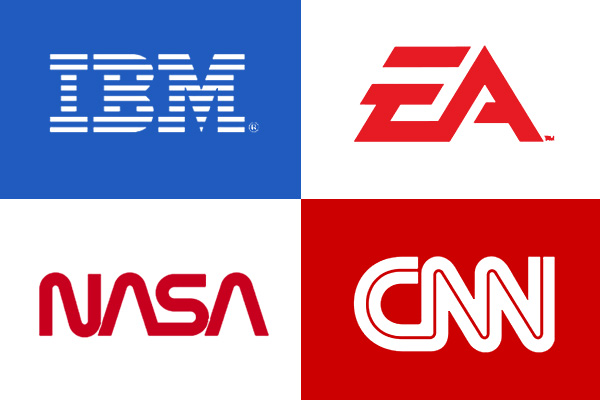
Examples
- IBM: The blue-striped initial letters of International Business Machines express reliability and technology.
- CNN: The simple bold design of Cable News Network represents clarity and authority of news broadcasting.
- NASA: The abbreviation has become synonymous with innovation and the exploration of space for the National Aeronautics and Space Administration.
Best Use Cases
- Complex or Long Names: Suitable for companies that wish to shorten their identity.
- Established Companies: Suitable for companies with already existing recognition, where the initials are widely recognized.
- Professional and Corporate Branding: Ideal for businesses in search of a formal, no-nonsense image.
3. Pictorial Marks
The pictorial marks are types of logos that symbolize the brand through an icon or graphic. These logos are obvious and memorable, relying on imagery to create the ‘initial association’ with the company. Gradually, without text, the symbol becomes immediately recognizable with the brand.
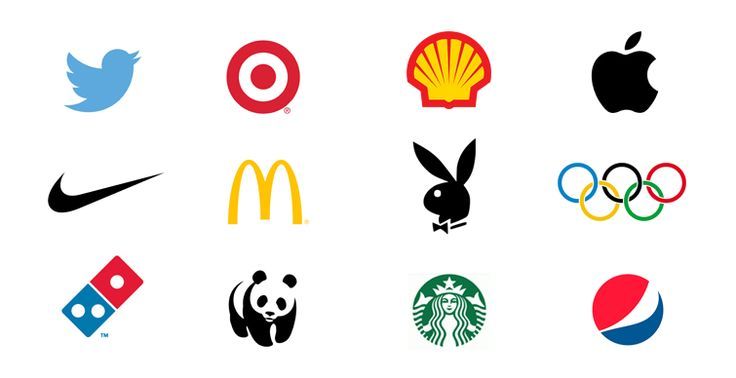
Examples
- Apple: The bitten apple is symbolic of simplicity, innovation, and elegance.
- Twitter: The small bird gives an impression of the brand as communication and freedom of speech.
- Target: The bullseye logo is a simple, memorable mark of precision and focus.
Best Use Cases
- Global Appeal: For brands wanting to transcend language barriers with an easily understood symbol.
- Strong Brand Identity: For businesses seeking to create a single, recognizable visual identity.
- Modern and Innovative Brands: Suitable for businesses that seek to communicate their creativity and originality with an image.
4. Abstract Marks
Abstract marks are shapes or non-representational forms in creating a distinctive logo. Unlike pictorial marks, they don’t depict any distinct object; instead, it evokes ideas, emotions, or brand qualities. Thus, abstract designs are versatile and can be used to represent various industries because the interpretation is flexible.
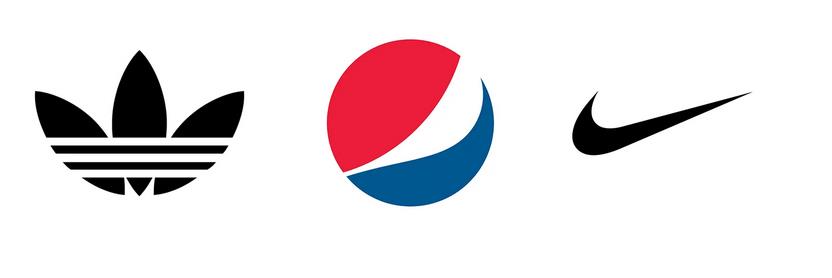
Examples
- Nike: The swoosh represents movement, swiftness, and athletic success.
- Pepsi: The circular shape with red, white, and blue waves embodies energy and vitality.
- Adidas: The three stripes embody performance and functionality.
Best Use Cases
- Innovative and Creative Industries: Ideal for brands which would want to express a cutting-edge, avant-garde image.
- Global Brands: Effective for companies seeking to communicate values and ideas without cultural or linguistic limitations.
- Versatile Design Needs: Suitable for businesses that want a logo adaptable to various media, from digital platforms to product packaging.
5. Mascot Logos
Mascot types of logos are unique characters or figures that represent the brand. The characters are often cartoonish and designed to be the company’s personality, values, or the interests of the target audience. So, they create an emotional connection, usually friendly or approachable. Mascot types of logos are most effective for brands targeting families, children, or a playful audience.
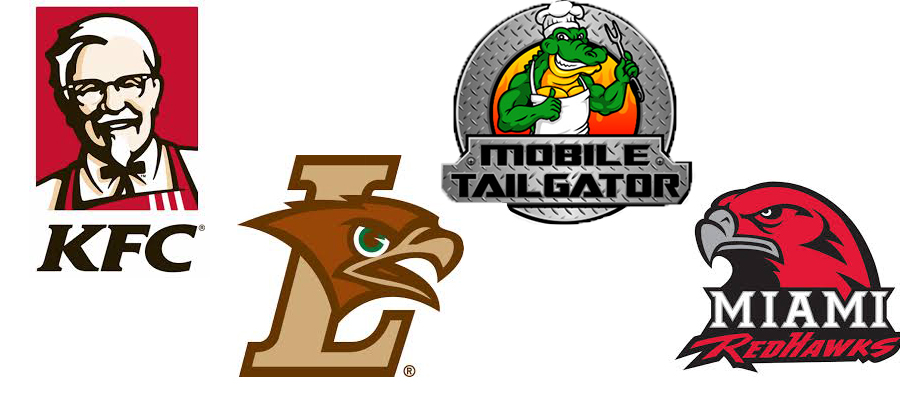
Examples
- KFC – Colonel Sanders: The face of KFC is undoubtedly Colonel Sanders. He is a classy character that also reminds people of tradition.
- Pringles – Mr. P: Pringles’ cheerful mascot with a mustache makes the snack look fun and something to relate to.
- Cheetos – Chester Cheetah: Chester is a mischievous and playful cheetah that represents the bold and exciting flavor of Cheetos products.
Best Use Cases
When to Use a Mascot for Your Logo Design:
- Building a Personal Connection: Mascots humanize brands, making them more relatable.
- Long-term Branding: Companies that want to create a unique, recognizable face over decades will greatly benefit.
- Expanding Marketing Efforts: Mascots work well across mediums, from TV ads to merchandise.
- Targeting Young Audiences: Suitable for brands such as food products, toys, or entertainment, where mascots appeal to children.
- Establishing Tradition: Brands with mascots tend to appear trustworthy and of olden times.
6. Combination Marks
Combination marks combine text (the brand name) with an icon, symbol, or image. The hybrid logo style offers flexibility since the elements can be used together or separately. These types of logos help to express the brand identity through visual and textual elements at the same time, thus providing clarity and memorability.
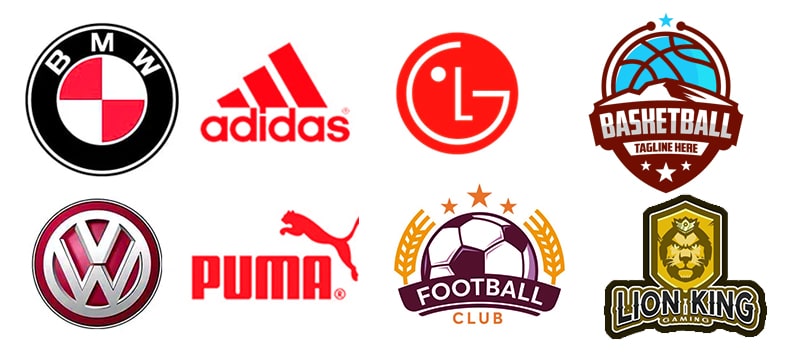
Examples
- Adidas: Simple yet athletic three stripes with a brand name. Every part highlights the international brand.
- Burger King: The name has been placed in the burger buns, thus forming a design. It appeals to their primary product- a burger.
- Doritos: The triangle-shaped icon combined with the brand name communicates the snack’s shape and bold flavor.
Best Use Cases
Why Combining Text and Symbols Works for Many Brands:
- Clear Brand Recognition: The dual elements reinforce the brand name and its visual identity.
- Broad Appeal: Suitable for both global audiences and niche markets, as the text aids recognition across languages.
- Flexible Applications: Works well for websites, packaging, business cards, and mobile apps.
- Brand Evolution: When brands become mature, they can opt to use either the text or the symbol independently in their types of logos.
- Communicating Dual Messages: The combination enables brands to pass two messages simultaneously: abstract ideas are conveyed through the icon, while direct information is delivered through the text.
7. Emblem Logos
Emblem types of logos are a pretty unique combination of text and images placed into a singular, geometric form such as a badge, crest, or shield. These are often formed with a name or slogan incorporated directly into the icon, creating a seamless and iconic design. Due to its symmetrical layout and intricate details, this is often perceived as a classic, formal, and professional-looking emblem.
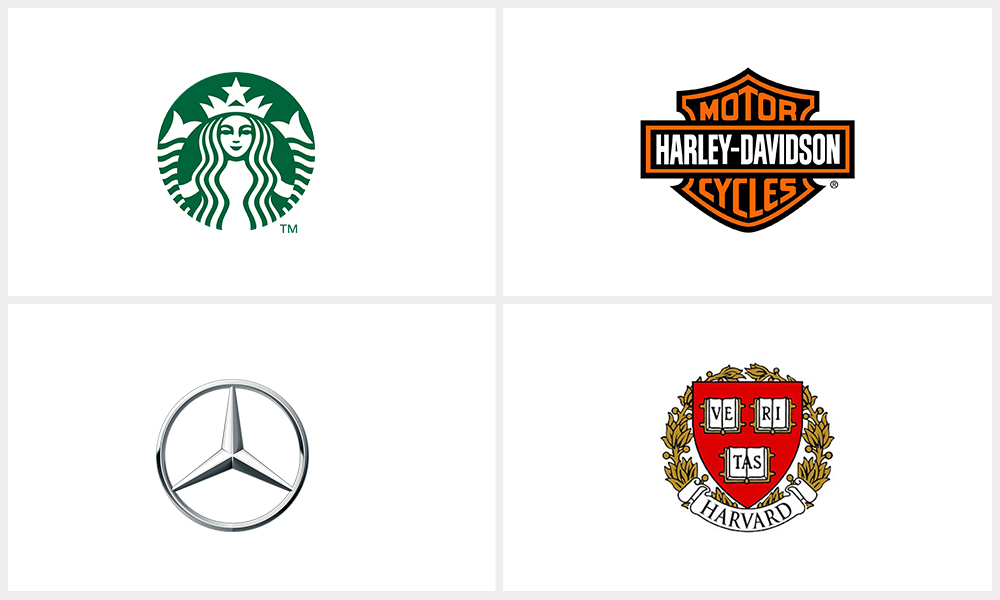
Examples
- Harley-Davidson: The Harley-Davidson emblem logo is a shield-based design with bold typography that symbolizes strength, durability, and legacy.
- Starbucks: Starbucks’ emblematic circular logo combines the brand name with an intricate siren illustration.
- BMW: The BMW emblem logo includes a circle with a checkered blue-and-white design, reflecting its Bavarian origins and heritage in the industry.
Best Use Cases
Sectors That Utilize Emblem Logo
- Education: Emblems in schools and universities communicate tradition and quality of academic excellence.
- Government and Not-for-profits: Emblem logos are perfect for conveying a message about authority and worthiness.
- Food and Beverage: Restaurants, breweries, and coffee shops use emblems to give a vintage, artisan feel.
- Automotive and Sports: Here, the emblems set an icon of heritage, performance, and dependability.
- Ideal Situations
- Brand Heritage Timelessness: Suitable for companies that wish to create a timeless, traditional identity.
- Multifunctional Usage: Suitable for official documents, merchandise, and product packaging
8. Dynamic Logos
Dynamic types of logos serve as versions adaptable and flexible in form but stable at the core. It often contains color, patterns, shapes, or animations that change according to context, audience, or theme. Dynamic logos are examples of modernity, creativity, and versatility.
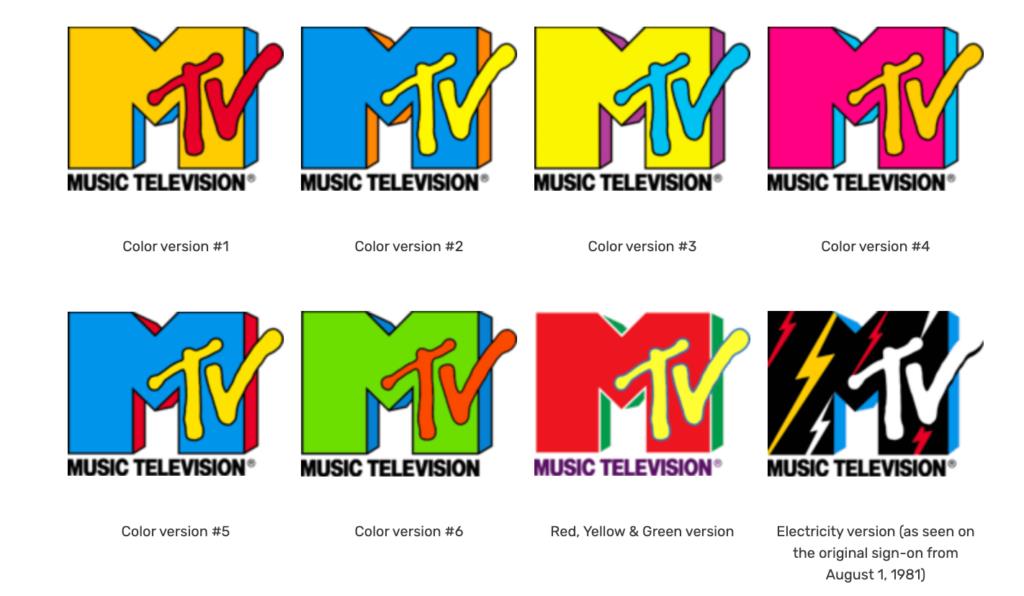
Examples
- Google: Google’s logo is an excellent illustration of the dynamic logo. Its basic design does not change, but the brand changes so often.
- MTV: MTV’s logo is an iconic example of the dynamic brand. The big “M” and “TV” are static, but the patterns and.
- Nickelodeon: Nickelodeon’s iconic splat logo has taken the form of many shapes and colors throughout the years, fitting the brand’s playful, youthful, and energetic persona.
Best Use Cases
Industries That Thrive with Dynamic types of logos:
- Media and Entertainment: Captivates the audience with innovative and constantly changing designs.
- Technology: Represents innovation and adaptability in the digital world.
- Retail and E-commerce: Changes branding to suit seasonal sales or promotional activities.
- Creative Agencies: Demonstrates creativity and originality through a dynamic design.
- Digital Marketing: Dynamic logos work well in interactive and animated formats.
- Cultural Relevance: Allows the brands to be relevant and leading for certain groups.
- Event-based Campaigns: Can be modified based on themed events, holidays, or partnerships.
Arvin AI: Revolutionizing Logo Design
Arvin AI is a game-changer when it comes to logo making, as it uses the latest artificial intelligence for creating a unique professional logo tailored to your business needs. You could be an entrepreneur, a freelancer, or even a corporate team member; with Arvin AI, it is now easier to create a beautiful logo with user-friendly tools and instant suggestions. Its AI-powered platform ensures high-quality designs aligned with your brand identity, the key to standing in that highly competitive market.
Arvin AI Key Features
1. Artificial Intelligence Driven Logo Creation
Arvin AI enables the creation of varied types of logos for businesses and individuals using sophisticated machine learning algorithms. It analyzes the input provided, like the business name or industry, to create logos that define your brand.
2. Highly Customizable
Users can fine-tune their designs by customizing colors, fonts, icons, and layouts. This gives brands the flexibility of creating a logo that truly reflects its vision and values.
3. Instant Logo Suggestions
Within seconds, Arvin AI submits multiple logo concepts based on your input. Each of these suggestions will take into account your business type and personal preferences, saving you time and effort along the way.
4. Multiples design modes
Arvin AI provides for “Quick Mode” quick results and “Professional Mode” more detailed configuration, to meet the needs of varied expertise and different users.
5. Brand Kit Integration
Easily integrate types of logos into a comprehensive brand kit, which ensures consistent designs across business cards, social media posts, and other marketing materials-all within minutes.
How to Use Arvin AI for Logo Creation?
Step 1: Go to the Arvin AI Website: Open your browser and go to the Arvin Logo Maker design page.
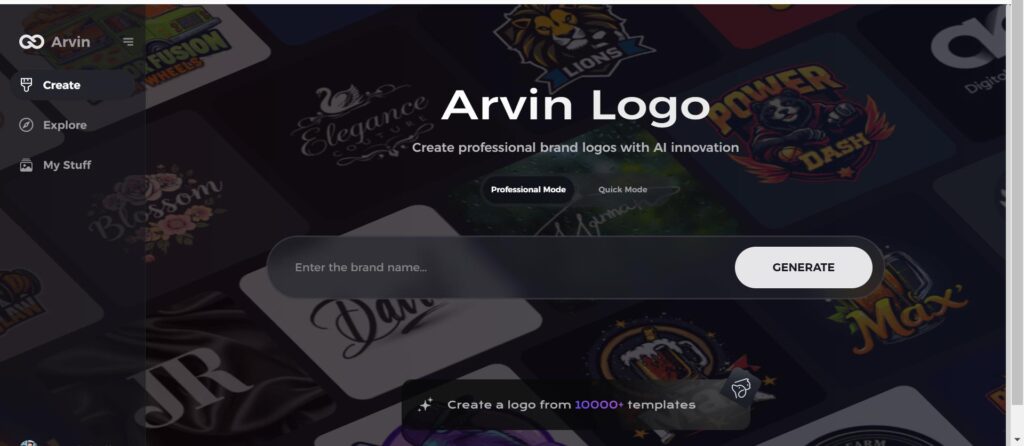
Enter Your Business Name and Category: Enter information about your business, such as its name and category, so that the AI can generate suitable designs.
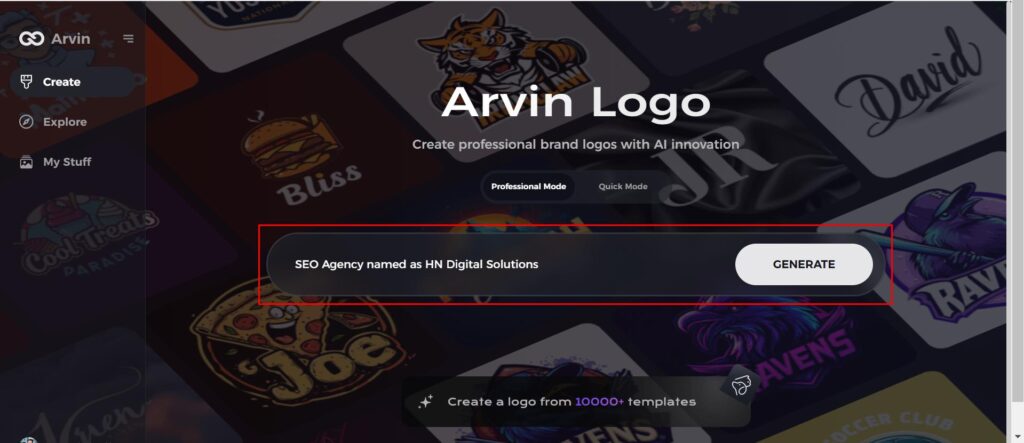
Step 3: Select your Industry: Now pick your industry this will help the AI generate logo styles and types that better suit your preferences.
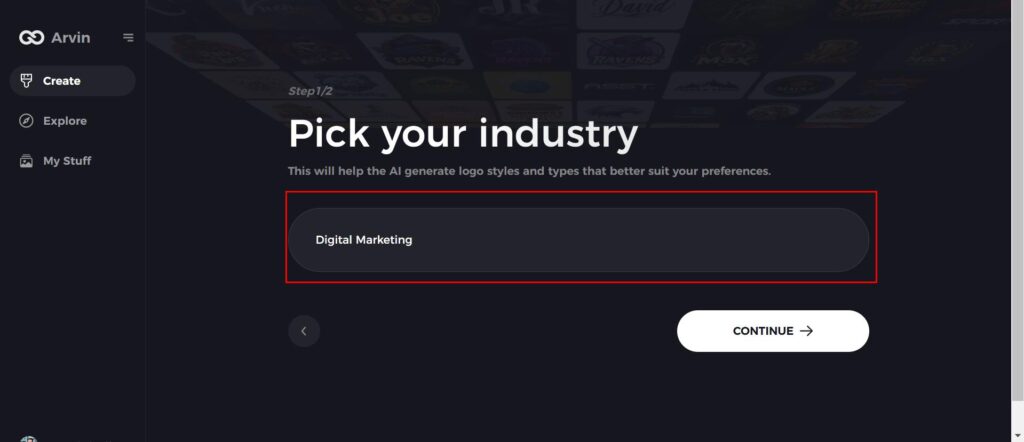
Step 4: Pick the style: There is multiple option of style. You chose style that likes you would want or remain it as non-style. This will serve as inspiration to create your preferred logo.
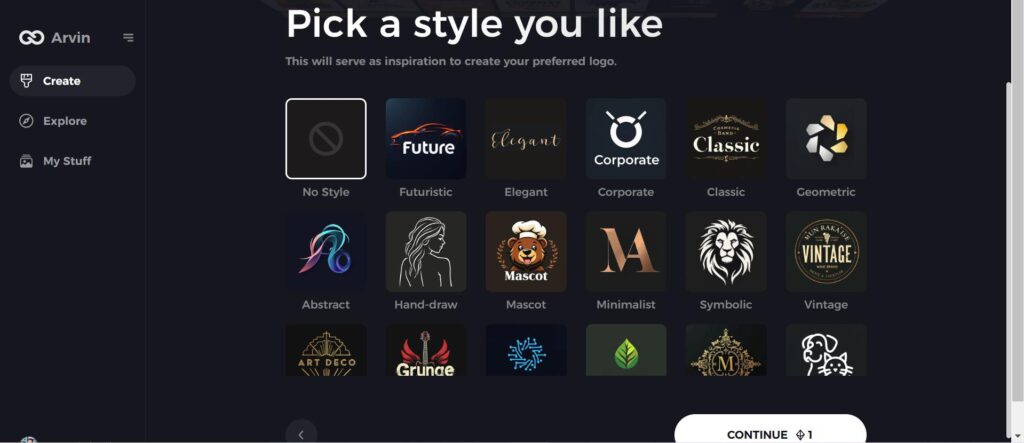
Step 5: Explore Logo Ideas: Arvin AI will automatically generate logo of your idea. Scroll through the options to see design that suit your brand identity.
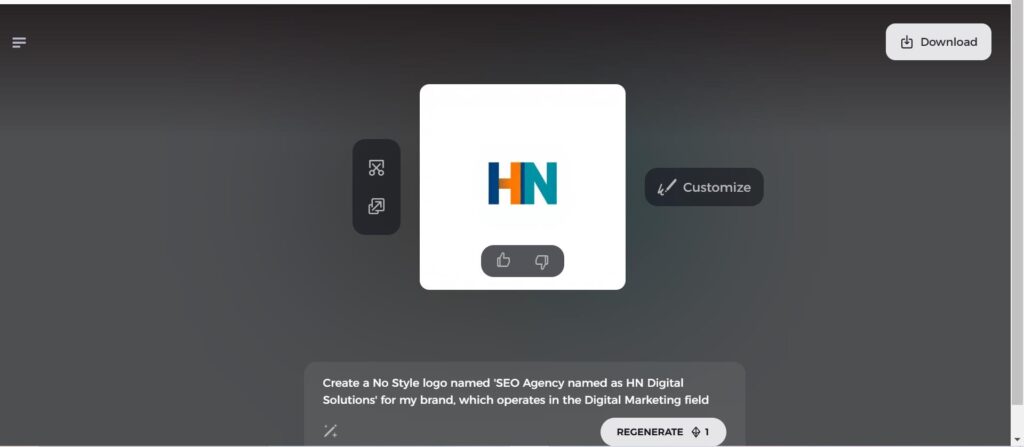
Step 6: Edit the Design: Adjust elements like the color scheme, typography, and iconography to match your brand’s style and preferences.
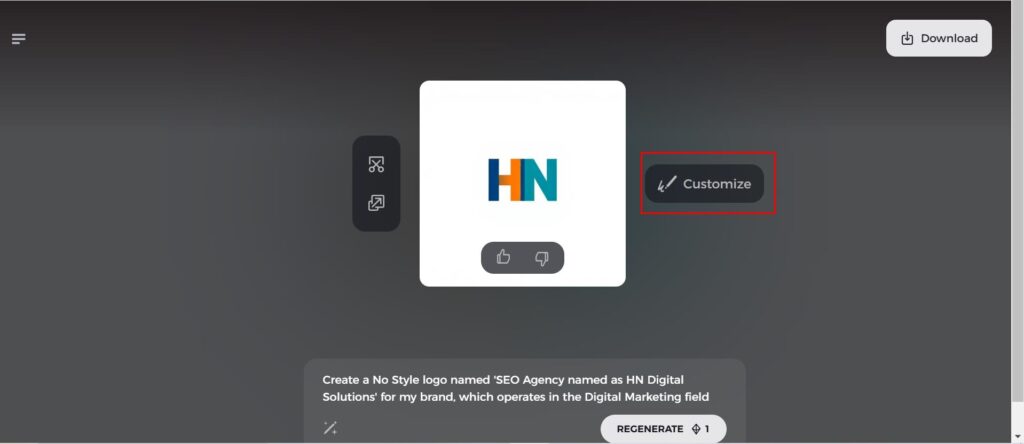
Step 7: Download Your Logo: Once satisfied, download your logo in multiple formats (e.g., PNG, or SVG) to ensure compatibility for various applications such as websites, social media, and print materials.
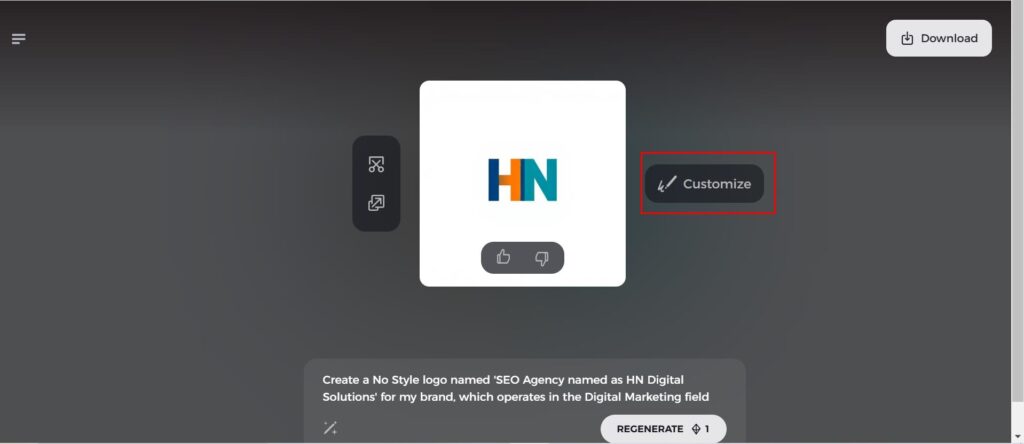
How to Choose the Right Logo for Your Brand?
1. Brand Identity
Your logo should capture the core values, mission, and personality of your brand. Reflect on what your business stands for and how a logo can visually represent that essence.
2. Target Audience
Understand the preferences and expectations of your target audience. A logo that appeals to your demographic can strengthen brand recognition and trust.
3. Industry Trends
Research your industry’s typical logo styles. While standing out is essential, aligning with industry norms ensures your logo remains relevant and professional.
How to Align Logo Types with Business Goals?
1. Minimalist Logos for Modern Brands
If your business emphasizes innovation and simplicity, opt for a clean, minimalistic logo to convey professionalism and forward-thinking.
2. Playful Logos for Creative Industries
For entertainment or design brands, a bright, playful logo may speak of creativity and friendliness.
3. Timeless types of logos for Traditional Brands
A timeless, sophisticated logo can create an impression of trustworthiness and reliability for a law firm or financial institution.
Logo Design Trends for 2024
1. Minimalism
Minimalist types of logos continue to dominate in 2024, focusing on clean lines, simple shapes, and strategic use of white space. Brands aim to convey sophistication and clarity, making these designs timeless and versatile. Examples include tech companies and modern lifestyle brands.
2. Dynamic Logos
Dynamic or adaptive logos are gaining traction as brands seek to create engaging and interactive experiences. These types of logos adjust based on context, such as different colors, shapes, or animations for digital platforms. For instance, Google’s adaptive logo dynamically morphs in various applications.
3. Geometric Shapes
Logos utilizing geometric shapes like circles, triangles, and polygons offer precision and structure. This trend appeals to industries like tech, engineering, and architecture for its modern and professional appearance.
4. AI-Generated Logos
Artificial intelligence tools are reshaping logo design by enabling faster iterations and unique styles. AI-generated types of logos allow small businesses to access high-quality designs without hiring professionals, democratizing the design process.
What’s next for Logo Design?
1. Incorporation of Motion and Interactivity
The future of logo design will integrate motion graphics and interactive elements more seamlessly. Animated logos have already proven popular for digital platforms for their dynamic storytelling capabilities.
2. Sustainability
Logos with a touch of environmental sensitivity, like earthy tones or a natural theme, will appeal to the masses increasingly becoming eco-sensitive customers. Brands are displaying their commitment to sustainability through their choices in design.
3. Hyper-Personalization
Customized types of logos which adapt to the user’s preference or location could be in the future, that would give one more access to the target audience. In the following years, personal experience will redefine a brand’s identity.
Common Mistakes to Avoid in Logo Design
1. Overdesigning
Many designers add too much to the logo, trying to make it more impressive, yet the most simple is usually the best, since a massive, cluttered design confuses the audience. Iconic types of logos such as Apple or Nike show how potentially powerful a few elements can be rather than many.
2. Ignoring Scalability
Scalability is often overlooked in logo design. A good logo must look superb on a business card and, at the same time, hold its grace on a billboard. One would have to scale types of logos into a different variety of sizes to ensure legibility and clarity even when printed as small as app icons.
3. Inconsistent Branding
The logo is the foundation of a brand’s identity, and inconsistency can cause confusion in a brand. A playful logo may not fit the tone for a luxury brand. Colors, fonts, and styles should be consistent in all branding materials.
Conclusion
A good logo forms the crux of a brand identity; it is a recognition and trust-building tool. From minimalist designs to dynamic and AI-generating logos, every type fills a specific role in brand value expression and audience connection. Arvin AI revolutionizes how types of logos are made by putting professional design within everyone’s reach while making the whole process easier. Using state-of-the-art AI technologies, it allows businesses of any scale to create logos that perfectly match the vision of your brand.
FAQs on logo design trends and mistakes
1. Why is minimalism as a trend, popular in logo design?
This is because they are easy to identify and can be adapted in any medium. Simple types of logos convey clarity and sophistication – it’s exactly what modern branding requires.
2. How does AI help in creating logos?
AI tools such as Arvin AI ease the logo-making process as they create unique designs rapidly, allow for customization, and bring high-quality types of logos to businesses that may not have extensive design knowledge.
3. What are the key considerations for logo scalability?
To ensure scalability, logos should maintain clarity and legibility at all sizes, from tiny app icons to large billboards. Using vector graphics and avoiding overly intricate details help achieve this.
4. How does inconsistent branding impact a company?
Inconsistent branding, such as a mismatched logo style or color scheme, can confuse audiences and weaken brand recognition. A cohesive logo that aligns with the brand’s identity ensures better recall and trust.

